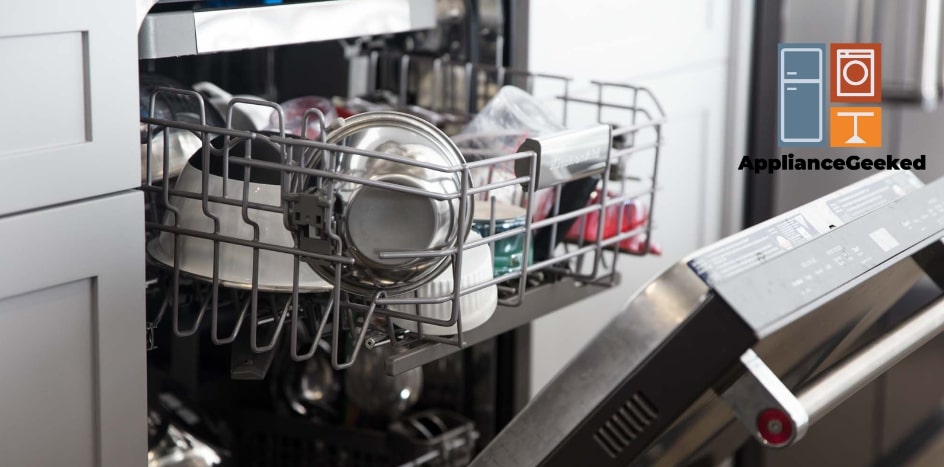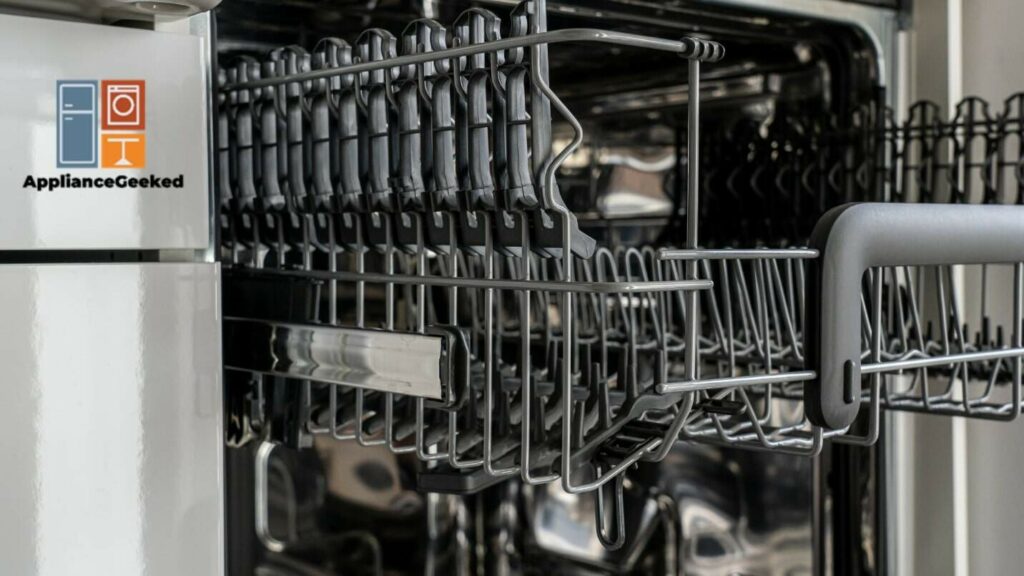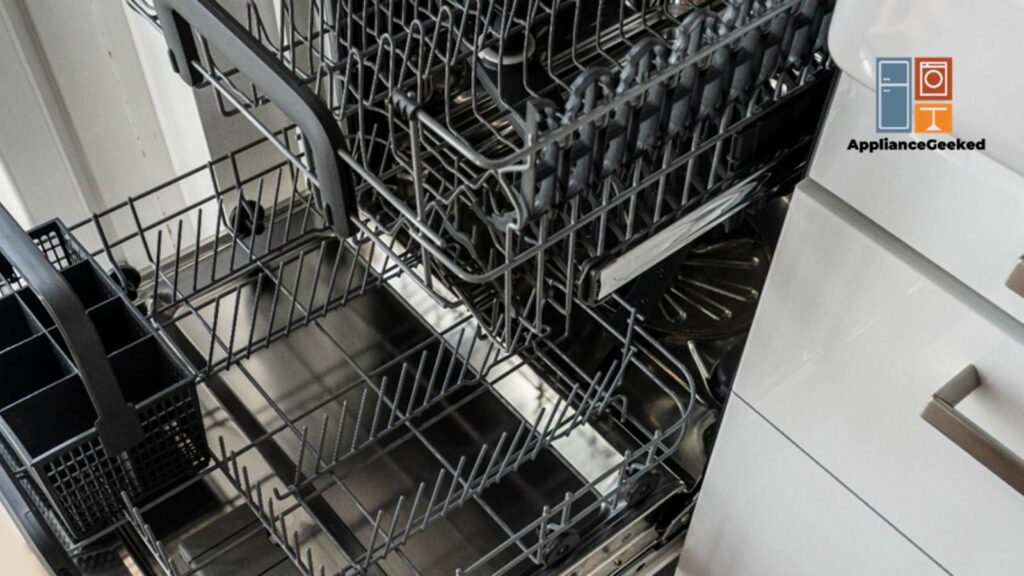Error codes shown by digital display or blinking lights mean that something is preventing your dishwasher from operating properly.
Since there are more than 30 error codes and light combinations in Samsung dishwashers, we made a list of all of them and their meanings to keep you on track.
What do Samsung dishwasher error codes mean?
The table below groups the error codes based on how your Samsung dishwasher shows them on its panels — digital display and blinking lights.
We also added some common troubleshooting methods to solve each issue.
| Digital Display | Blinking Lights | Meaning | Solution |
| 1E, IE (Waterwall Models) | Clogged Filter Error | Carefully take out the filter and clean it with running water, a soft brush, and mild soap. | |
| 3C | Pump Operation Error | Check for blockages in the drain hose and drain filter. If they are clear, look for damage in the drain pump components such as the drain impeller and solenoid. | |
| 3E | Normal, Delicate, and Quick Normal, Delicate, and Smart Auto Normal, Quick+, and Smart Auto | High-Temperature Water Supply Error | Verify that your dishwasher isn’t connected to a hot water supply or that the temperature is not set above 176°F. Once you have checked the temperature, try unplugging and restarting your dishwasher. |
| 4C, 4E | Auto Express 60 Quick Smart Auto | Water Supply Error | Ensure that the water temperature and pressure meet the requirement for a proper cycle. Then, check for any plumbing issues, clogs, or damages in the water inlet hose and valve that may restrict the flow of water. |
| 5C, SC, 5E, SE | Delicate Quick+ | Drain Error | Take out the drain filters and clean them. You should also clean the sump area and inspect the drain’s connection at the sink, making sure that the hose is properly connected and isn’t clogged, bent, or damaged. |
| 7E | Waterwall Reflector Error | Check that the waterwall reflector’s tape has been removed and if there is anything that’s blocking it from moving freely. Also, make sure that it has been installed and positioned correctly. | |
| 9E | Normal, Heavy, and Quick Normal, Heavy, and Smart Auto | Low-Level Water Error | Make sure that the water supply has been turned on and that your home isn’t experiencing any plumbing issues. Once you’ve tested the water pressure in your home, check for clogs in the water inlet hose, valve, and mesh filter that may be preventing the water from coming in. |
| bE, 6E | Auto and Express 60 Auto, Normal, and Express 60 Normal and Delicate Normal and Quick+ | Button error | Unplug the dishwasher and disconnect it from the circuit breaker. Try pressing all the buttons to ensure that they are positioned correctly. You can also clean the board panel since filth may be causing the buttons to get stuck. Then plug your dishwasher back in and reboot it. |
| CE | All Four Lights | Communication Error | If the control panel is unable to communicate with the rest of your dishwasher, try unplugging it and turning it back on again. If this doesn’t work, you may have to call an expert since it could be a wiring issue. |
| HC, 1E, IE (Rotary Models) | Auto and Normal Normal and Quick Normal and Smart Auto | High-Temperature Heater Error | To make sure that this isn’t a systemic issue, unplug your dishwasher from the circuit breaker, turn it back on again, and try a normal cycle. If this doesn’t work, there may be a malfunctioning heating component that needs to be replaced. |
| HE | Heavy and Delicate Heavy and Express 60 Heavy and Quick+ | Heater Error | If the temperature inside the dishwasher is detected incorrectly, this may be caused by a faulty thermostat that needs to be fixed or replaced. There may also be damage to the heating elements that are causing failure in regulating the heat inside your dishwasher. |
| LC, LE | Heavy (models without Express 60) Normal | Leakage Error | Dry out any external water sources near the dishwasher. Make sure that the hoses are connected securely and that your machine isn’t tilted. Also, check for clogs in the hoses, filters, valves, and water nozzles. Some components such as the dispenser or the gasket may be damaged, so replace them whenever possible, |
| OC, 0C, oE | Auto and Heavy Heavy and Quick Heavy and Smart Auto Heavy (models with Express 60) | Over-Level Water Error | The over-level error is commonly a result of a draining issue. Make sure that the draining filter, hose, sump area, and flapper are free from blockages and clogs. You can also check for continuity in the drain and ensure the valve is functioning properly. |
| tE | Heavy, Delicate, and Quick Heavy, Delicate, and Smart Auto Heavy, Quick+, and Smart Auto | Temperature Sensor Error | If the error is caused by an issue in its control board, you may be able to resolve this by unplugging and rebooting your dishwasher. If the error persists, the sensor itself may be faulty and needs to be replaced. |
| Delicate and Quick | Door Open Detected | Be sure that the door is closed properly. A tilting dishwasher could also cause the machine to detect an open door. Ensure that your dishwasher is leveled properly and that there aren’t any snags inside the dishwasher door. | |
| Normal, Heavy, and Express 60 | Short-circuited Thermistor | Switch the power off from your dishwasher to avoid any damage caused by fluctuating heat. Call a professional appliance repair service to fix or replace your dishwasher’s thermistor. | |
| Normal and Heavy | Faulty Thermistor Error | ||
| AP | Access Point Mode | These errors usually originate from an issue in the control panel itself and could be resolved by unplugging your dishwasher and restarting it. | |
| PC | Zone Wash Error | ||
| PE | Half Load Function Error |
What causes the error codes to appear and how do you address them?
Now that you know what the error codes mean, here are some of the reasons they occur and helpful tips to avoid them in the future.
Systemic Errors
Errors such as a stuck button, zone wash error, half load function error, and communication errors between the control panel and motor are usually caused by programming or wiring issues.
Since the control system is only designed to carry out simple commands, avoid pressing the dishwasher buttons too many times consecutively.
This will cause your buttons to be stuck and some of the commands to lag, causing your control board to become unresponsive.
Also, when there’s a power outage, remember to unplug your dishwasher.
The sudden power surge when the electricity comes back on can damage your dishwasher and speed up the wearing out of your wiring and control system.
Leaking Errors
Leaks are one of the most common problems with dishwashers. If your dishwasher is new, leaks are most likely caused by an installation error or clogs in some of its components.
On top of making sure that your dishwasher is installed correctly, be sure to clean the filters in your dishwasher regularly.
This is to avoid food residue and detergent suds from piling and causing a water blockage.
Also, remember to clean and dry out the areas around the dishwasher regularly since they may become a source of moisture, causing the leak sensor to go off.
Lastly, remember to put the right type and amount of detergent for each cycle as they may also cause too much moisture when improperly used.
Draining Errors
Draining and over-level water errors are caused by the same issues.
When your dishwasher is unable to drain the water properly, it signals that something is restricting the water from coming out or a draining component is malfunctioning.
Clogging is a likely suspect for most draining errors. So before placing your dirty dishes inside your dishwasher, clean out as much food waste from your dishes as possible.
Also, clean the drain filter and sump area regularly. Not only will this prevent draining issues in the future, but it will also keep your dishwasher from smelly odors and from spraying dirty water all over your dishes.
Heating-Related Errors
Your Samsung dishwasher’s heating elements and sensors can malfunction due to wiring issues or simply because of wear and tear.
However, there are things you can do to help prolong their lifespan.
To keep your dishwasher from generating too much heat, don’t stack too many dishes inside the racks. The more there is to clean and dry, the longer your heating elements work.
Also, make sure to clear out the dishwasher vents from any clogs or debris.
If the vents are blocked, the steam from inside the dishwasher gets trapped, causing the heat to linger longer than it should.
And there you have it! The next time your dishwasher surprises you with an error code or a bunch of flickering lights, you know what to do.
Of course, before you do any tinkering, don’t throw safety out of the window. Wear proper safety equipment, and when in doubt, call in extra help from the professionals!




